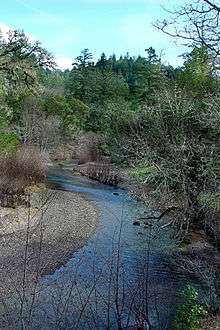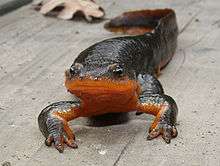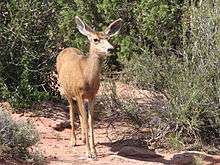Galbreath Wildlands Preserve
| Galbreath Wildlands Preserve | |
|---|---|
| GWP | |
|
Waterfall at Galbreath Wildlands Preserve | |
 Map of California | |
| Location | Mendocino County, California, United States |
| Nearest city | Boonville |
| Coordinates | 38°52′15″N 123°15′50″W / 38.87083°N 123.26389°WCoordinates: 38°52′15″N 123°15′50″W / 38.87083°N 123.26389°W |
| Area | 3,670 acres (14.9 km2) |
| Established | 2004 |
|
www | |
The Galbreath Wildlands Preserve is a 3,670-acre (14.9 km2) nature reserve in Mendocino County, California established in 2004 in honor of Fred Burckhalter Galbreath (1901-2000). The preserve, a former sheep ranch, is located near Yorkville, California.[1]
History
Galbreath worked in the marine insurance business in San Francisco for many years. In 1944, he purchased property in southern Mendocino County as a working sheep ranch and undertook projects to improve the health of habitats on the property. He reduced sedimentation by undertaking drainage improvement projects, removed the invasive wild boars through hunting, and engaged in selective forestry to reduce downed woody debris and remove old and diseased trees. Galbreath sought to protect his land in perpetuity as a site for higher education.
After he died at the age of 98[2] in April 2000, Fred Galbreath's family Bob and Sue Johnson and Nancy and Kleve Johnson, donated the property to Sonoma State University as a teaching and research site.
Land
The 3,670-acre (1,490 ha) Galbreath Wildlands Preserve lies in the upper Navarro Watershed in the Coast Range of northern California. Located approximately 17 miles (27 km) inland from the Pacific Ocean in southern Mendocino County, this topographically diverse landscape ranges from 900 to 2,200 feet (275 to 670 meters) in elevation and includes coniferous forests (Douglas-fir and redwood), mixed hardwood-conifer forests (Douglas-fir, tanoak, madrone), oak woodlands (mostly black and Oregon white oaks), and annual grasslands and riparian woodland. Rancheria Creek flows northward through the preserve, along with numerous seasonal tributaries, and drains into the Navarro River.
Geology
The Navarro River watershed contains the highly erodible Franciscan melange and alluvial fill, as well as the Coastal Belt of the Franciscan Assemblage, which is more stable and resistant to erosion. Alluvial fill occurs in Anderson Valley and low-lying areas of major tributaries and Franciscan melange is associated with middle and upper Rancheria Creek. Most of the rest of the watershed contains soil derived from the Coastal Belt of the Franciscan Assemblage.[3]

Hydrology
The Galbreath Preserve lies in the upper Rancheria subbasin of the Navarro Watershed and contains 1st, 2nd, 3rd, 4th, and 5th[4] order streams. "Throughout the Navarro watershed, recent alluvium, stream channel, and terrace deposits provide groundwater recharge to surface streams and supply wells and springs. The Franciscan formation contributes only minor amounts of groundwater. Flows dry up in tributaries during summer months, with the only surface water present derived from springs. Only the mainstem Navarro River, North Fork Navarro River, and lower reaches of Anderson, Rancheria, and Indian Creeks contain year-round surface water. Since 1951, a USGS stream flow gage has been maintained about nine miles upstream of the mouth of the Navarro."[4]
Vegetation

Preserve staff, classes, and other visitors have begun to document occurrences of plant species. Habitat types in the Navarro watershed include redwood forest (42%), montane hardwood (24%), annual grassland (14%), Douglas-fir forest (9%), and montane hardwood conifer (6%). In the Rancheria subbasin, vegetation distribution and cover is also similar to the entire watershed: redwood forest (37%), montane hardwood (30%), annual grassland (17%), and Douglas-fir forest (6%).[4]
"Redwood forest is a composite name for a variety of conifer species growing in the coastal zone and is usually a mixture of several tree species, including redwood, Sitka spruce, grand fir, red alder, and Douglas-fir. Near the coast and in flood plains, redwood is the dominant tree species with Douglas-fir becoming dominant further inland and higher in the watershed where tanoak and madrone are its primary associates. Montane hardwood habitat typically consists of an evergreen hardwood tree layer, a patchy shrub layer, and sparse herbaceous cover. Canyon oak is the usual dominant on steep slopes, replaced by huckleberry oak at higher elevations and pines at still higher elevations. Associates include tanoak, Pacific madrone, Douglas-fir, and California black oak. Annual grassland habitat is open and composed primarily of annual plant species; non-native forage grasses are usually dominant. Douglas-fir forest is characterized by a high, irregular overstory of Douglas-fir with a lower overstory of densely packed sclerophyllous broad leaved evergreen trees such as tanoak and madrone."[4]
Vegetation types in the watershed roughly follow soil type. Franciscan melange derived soils support grassland, the Franciscan Coastal Belt derived soils support grass-scrub or forested vegetation, and valley fill supports mixed forest.
Vertebrates

Documentation of species occurring on Galbreath Preserve lands has only just begun. To stimulate further documentation of these species we list vertebrates identified by West Coast Wildlands (2007) with potential to occur on Galbreath lands.
Predicted amphibians (18 species) - These species include California giant salamander (Dicamptodon ensatus), southern torrent salamander (Rhyacotriton variegatus), ensatina (Ensatina eschscholtzii), tailed frog (Ascaphus truei), California red-legged frog (Rana aurora draytonii), and the invasive American bullfrog (Rana catesbeiana). Although specific habitat requirements vary, all of the amphibians predicted to occur in the Rancheria Creek subbasin require a cool, moist environment close to or within rocky streams, pools, or springs and most prefer coniferous forest habitat.
.jpg)
Predicted reptiles (20 species) - Reptiles include sagebrush lizard (Sceloporus graciosus), southern and northern alligator lizard (Elgaria sp.), rubber boa (Charina bottae), gopher snake (Pituophis catenifer), western rattlesnake (Crotalus oreganus), and California mountain kingsnake (Lampropeltis zonata). The reptiles generally inhabit drier upland habitat and are likely to be found in montane hardwood forest and grassland.

Predicted mammals (76 species) - Mammals may include American beaver (Castor canadensis), ringtail (Bassariscus astutus), American marten (Martes americana), fisher (Martes pennanti), weasels, American badger (Taxidea taxus), western spotted skunk (Spilogale gracilis), striped skunk (Mephitis mephitis), mountain lion (Puma concolor), bobcat (Lynx rufus), mule deer (Odocoileus hemionus), and elk (Cervus elaphus). Non-native species predicted to occur in the subbasin are wild pig (Sus scrota), fallow deer (Dama dama), red fox (Vulpes vulpes), and Virginia opossum (Didelphis virginiana).
Predicted birds (219 species) - Birds may include pelagic birds, wading birds, ducks and other water birds, raptors and other birds of prey, ground nesters, owls, and passerines. The species likely to occur in the Rancheria Creek subbasin is a subset of this list and likely does not include birds that remain along the coast, although occasional vagrants may be spotted. The brown pelican is predicted to occur in the watershed and the federally threatened marbled murrelet and northern spotted owl may also be found. The marbled murrelet (Brachyramphus marmoratus) and northern spotted owl (Strix occidentalis caurina) are of special concern because they are closely associated with old-growth and mature redwood forest, which has been heavily impacted by timber harvest since the late 1800s.
Fish include coho salmon (Oncorhynchus kisutch) and steelhead trout (Oncorhynchus kisutch). Coho salmon (Central California Coast Evolutionarily Significant Unit) and steelhead trout (Northern California Evolutionary Significant Unit) are listed as threatened.[4]
A trip camera on the site has documented the presence of American black bear, wild boar, bobcat, coyote, mule deer, gray fox, and wild turkey.[5]
Land use

Within the Rancheria Creek subbasin, major land uses include sheep and cattle ranching, timber harvest, and open space and rural residential homes, with only a few locations in field and row crops. Like much of the rest of the North Coast of California, timber harvest began in the mid-nineteenth century and has continued to the present. By the 1870s, sheep and cattle ranching had begun. Only recently have agriculture practices begun. Between 1984 and 1996, the number of new vineyards drastically increased in the upper subbasin and numbers continue to rise. Present day land use in the Navarro watershed is 70% forestry, 25% ranching, and 5% row crops, orchards and vineyards, with a small percent rural residential development.
Timber harvest, roads, agricultural practices, grazing management, grading, and other land disturbances contribute to high levels of sedimentation in the Navarro River watershed. Sediment production rates decreased during the 1980s and '90s from historic highs during the 1950s through '70s due to changes in harvest practices and improved construction and maintenance of active logging roads.
Climate
The Navarro River watershed receives about 40 inches of rainfall with about 60% falling during winter months from mid-December through the end of March. Rainfall and floods are seasonal, falling primarily between October and May, and are typical of the wet Mediterranean-type climate of north coastal California. Large storms and floods are episodic. Since the 1950s significant floods have occurred frequently, on a temporal scale of about once a decade.
Facilities
Facility planning is currently in process for developing on-site utilities and buildings to support educational and research use of the site. As part of this effort, we are including plans for an astronomical observatory that will be used for advanced research, instruction, and outreach. The observatory will be a remotely operated 1-metre (3.3 ft) telescope for finding extra-solar planets and near-Earth asteroids.[6]
Facilities at the Preserve are limited to two campgrounds for overnight stays or day use. The larger campground is located along Rancheria Creek and includes only a fire ring. The small campground is located approximately 0.5 miles from the entrance and is supported by a composting toilet. For both sites, all water must be brought in by visitors. A small storage shed is available for researchers interested in leaving equipment on site.
An 8-mile road traverses most of the Preserve and is 4-wheel drive accessible only. Access may be restricted immediately after a rain. Phone service is not available. Cell phone reception is possible at only two sites within the Preserve.
See also
References
- ↑ "'A piece of heaven'". Santa Rosa Press-Democrat. 28 March 2004. Retrieved 17 April 2011.
- ↑ "Fred Galbreath obit - 2000". 28 April 2000. Retrieved 31 October 2011.
- ↑ Florsheim, Joan (April 2007). "Upper Rancheria Creek Baseline Fluvial Geomorphology: Reconnaissance Assessment" (PDF). Archived from the original (PDF) on 7 June 2010. Retrieved 31 October 2011.
- 1 2 3 4 5 "West Coast Watershed (2007)" (PDF). 14 May 2007. Archived from the original (PDF) on 7 June 2010. Retrieved 31 October 2011.
- ↑ "SSU Nature Preserves - Trip Camera Images". Archived from the original on 23 December 2010. Retrieved 17 April 2011.
- ↑ "SSU reaching for stars". Santa Rosa Press-Democrat. 8 February 2006. Retrieved 17 April 2011.
